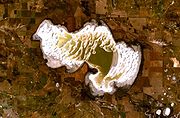
Natural Sequence Farming
Encyclopedia

Peter Andrews (agricultural pioneer)
Peter Andrews is an Australian race horse breeder and grazier from Bylong in the Upper Hunter Valley of New South Wales.-Agricultural pioneer:...
, in the 1970s. From the 1970s till the mid 2000's, Natural Sequence Farming was ignored and rejected by many farmers, the agriculture industry and local, state and federal governments, but these bodies have since come full circle and today NSF is recognised as a viable solution to environmental regeneration.
The method involves implementing major earthworks on a given area of land that has been devastated by deforestation
Deforestation
Deforestation is the removal of a forest or stand of trees where the land is thereafter converted to a nonforest use. Examples of deforestation include conversion of forestland to farms, ranches, or urban use....
and general agricultural activities, to emulate the role of natural watercourses in an effort to reverse salinity, slow erosion and increase soil and water quality to enable native vegetation to regenerate and restore the riparian zone
Riparian zone
A riparian zone or riparian area is the interface between land and a river or stream. Riparian is also the proper nomenclature for one of the fifteen terrestrial biomes of the earth. Plant habitats and communities along the river margins and banks are called riparian vegetation, characterized by...
.
The method does not require the use of artificial fertilisers or herbicides.
Flood Control
Flood events may occur only once every 1 or 2 years, however they have the ability to enhance or destroy a property. If the waters move too fast over bare land, then they can strip away topsoil and nutrients, leaving behind barren sands. By inserting barriers across creeks and encouraging water to spread outwards, the energy of a flood is reduced, waters tend to deposit soil from upstream, and the water can soak into the land. This encourages grasses and fast growing plants to take root.The role of weeds
Ground cover protects the land from drying and baking, and also stabilises the land in future flood events. While rye and other grasses have long been seen as beneficial crops for grazing, other plants that have been considered weeds can improve the soil, augment the growth of other crops, and assist the diet of grazing animals. These 'weeds' should not be removed. When they die naturally they should be cut for feed or used as green manureGreen manure
In agriculture, a green manure is a type of cover crop grown primarily to add nutrients and organic matter to the soil. Typically, a green manure crop is grown for a specific period of time , and then plowed under and incorporated into the soil while green or shortly after flowering...
.
Many 'weeds' only thrive in the regenerative cycle. Once the land recovers fertility the weeds tend to be replaced naturally by trees.
Case Studies
The first case study in which Natural Sequence Farming was successfully implemented was the 3,000 hectare Tarwyn Park in the Upper Hunter River catchment, formally affected by deforestation and high salinity levels, amongst much else. Other case studies include successful retailer Gerry HarveyGerry Harvey
Gerry Harvey is an Australian entrepreneur best-known for being the executive chairman of Harvey Norman Holdings Ltd., a large company which runs Australian retail chain Harvey Norman...
's nearby property, Baramul Stud.
Fraudulent NSF
Since the 1990s, there have been a number of cases where individuals or groups have sought financial gain through offering fraudulent versions of NSF.Many of these cases are discussed and exposed on the NSF here.
See also
- Salinity in AustraliaSalinity in AustraliaSoil salinity and dryland salinity are two problems degrading the environment of Australia. Salinity is a concern in most states, but especially in the south-west of Western Australia....
- Environment of AustraliaEnvironment of AustraliaThe Australian environment ranges from virtually pristine Antarctic territory and rainforests to degraded industrial areas of major cities.- Issues :...
- Conservation in AustraliaConservation in AustraliaConservation in Australia is an issue of state and federal policy. Australia is one of the most biologically diverse countries in the world, with a large portion of species endemic to Australia...
- Irrigation in AustraliaIrrigation in AustraliaIrrigation in Australia is a widespread practice to supplement low rainfall levels in Australia with water from other sources to assist in the production of crops or pasture. As the driest inhabited continent, irrigation is required in many areas for production of crops for domestic and export use...
- Climate change in AustraliaClimate change in AustraliaClimate change has become a major issue in Australia due to drastic climate events since the turn of the 21st century that have focused government and public attention. Rainfall in Australia has increased slightly over the past century, although there is little or no trend in rainfall in northeast...
- Bill MollisonBill MollisonBruce Charles 'Bill' Mollison is a researcher, author, scientist, teacher and naturalist. He is considered to be the 'father of permaculture', an integrated system of design, co-developed with David Holmgren, that encompasses not only agriculture, horticulture, architecture and ecology, but also...
- Seawater GreenhouseSeawater GreenhouseThe Seawater Greenhouse is a technology that enables the growth of crops in arid regions, using a greenhouse structure, seawater and solar energy...

